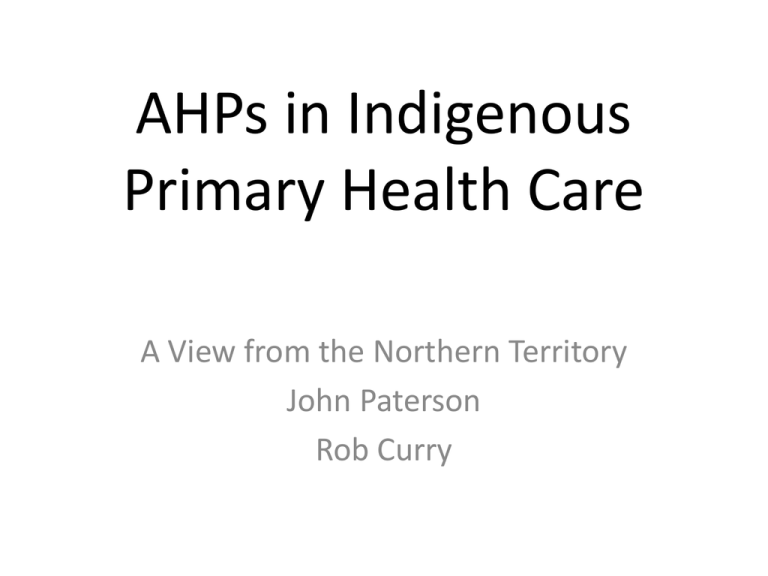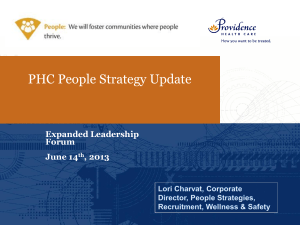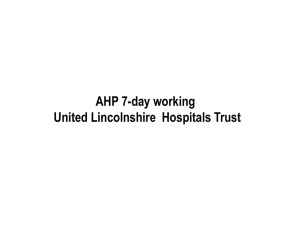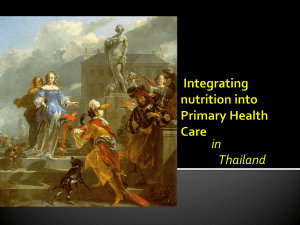AHPs in Indigenous Primary Health Care – A View from the Northern
advertisement

AHPs in Indigenous Primary Health Care A View from the Northern Territory John Paterson Rob Curry Presentation Summary • • • • • • AMSANT Context of remote Australia AHPs in Remote Health Aboriginal PHC Reform in the NT AHPs in NT PHC Reform Key issues for consideration AMSANT • The Aboriginal Medical Services Alliance of the Northern Territory • Peak body for 24 Aboriginal community controlled health services in the NT AMSANT Our Vision Improve the health of Aboriginal Territorians Key Strategies • Build support for member organizations • Strengthen leadership amongst membership • Advocate for health equity • Build effective relationships in Aboriginal health • Grow the community controlled sector Aboriginal Community Controlled Health • Independent incorporated health organizations (170 around Australia) • Elected Aboriginal Boards of Management • Principal funding source: DoHA • Answerable to communities & funders • Committed to comprehensive PHC • Committed to Closing the Gap • NACCHO as national peak body Healthcare in Remote Australia Remote Health Context • 30% of Australians live in rural/remote regions – about 7 million • 5% live in remote Australia – about 1 million • Rural/remote health is worse than metro • Health deteriorates with distance from cities • Reasons for poorer health - social determinants • Poorer access to services; eg. health, transport, education, etc. • Many Aboriginal people live remote Remote Health Context Productivity Commission report on Australia’s Health Workforce (2005):• “The importance of providing appropriate, sustainable, high quality health care to all Australians, regardless of their socioeconomic circumstances or geographic location, is paramount.” Remote Health Context Different Healthcare Models Needed for the Bush “Providing services for people in rural/remote areas where the population and service infrastructure is sparse presents particular challenges for both government and community sectors. These include additional costs, lack of service infrastructure and service options, transport difficulties and difficulties in recruitment and support of staff …”. Chenoweth & Stehlik Remote Health Context • Remote communities lack scale for services • Remote residents must access care from larger towns & cities. • Do we deliver services to people or people to services? • Limited service access results in unmet needs & poor health outcomes. • Must build/expand local PHC services The NT is Remote • • • • Vast geography – same size as South Africa Unique population demographics Poor health picture Health service delivery arrangements - 5 regional hospitals - Mainstream general practice - Urban community health - Private AHP services - Aboriginal PHC (largely remote) NT Demographics • • • • • • Vast area, sparse population = 220,000 Aboriginal people are 30% of population Darwin = 120,000; Alice Springs = 30,000 Most people in remote areas are Aboriginal Many small remote Aboriginal communities Unique jurisdiction Remote AHP Services AHPs in Remote Health Limited AHP services in the bush. Why??? • AHPs, nurses & AHWs are States responsibilities • Medicare covers doctors (Commonwealth funding) • Poor State funding for AHP services in the bush • No national approach to developing comp PHC • Consequence - limited development of remote AHP services. AHPs in Remote Health • Low per capita AHP services in remote • Example physiotherapy. High per capita rates in big cities, low rates in NT (AIHW, 1998) Adelaide – 1:1300 NT = 1:2500 • Medicare supports urban General Practice • Medicare fails to support multi-disciplinary PHC • Market failure for health care in remote National Healthcare Reform & AHPs Nicola Roxon (Federal Health Minister, 2008) “ Prevention of illness and chronic disease is central to a sustainable health system and a fuller life for all members of the Australian community. Too often in the past, individuals, communities and governments have focused on the immediate issues of treating people after they become sick. Whilst this will always remain vital, and there is much to do in this area, we cannot afford to limit our focus to treatment and ignore prevention.” National Healthcare Reform • AHPs fit well with comprehensive PHC & prevention • AHPs trained in effective health promotion • To build comp PHC, must build AHP workfrce • Reform Medicare ie. universal ‘health’ care, not just ‘medical’ care • Medicare Locals offer some hope for reform Aboriginal PHC in the NT Challenges for Aboriginal PHC in NT • High Aboriginal morbidity/mortality • Workforce shortages, particularly AHWs & AHPs • Lack of Aboriginal people in health workforce • Dispersed population, isolated communities • High service delivery costs for remote • Market failure for health care – dependence on grant funding Reforming NT Aboriginal PHC • Advocacy for PHC reform for 30 years • NT Aboriginal Health Forum is key reform body • Forum includes:- AMSANT - NT Health - Commonwealth Health Key NT PHC Reforms 1. 2. 3. 4. 5. Pathways to community control of PHC Regionalization of Aboriginal PHC Core PHC services Funding formula for equity Expanded PHC services from Emergency Intervention & now Stronger Futures Regionalization of PHC • 14 regional Health Service Delivery Areas (HSDAs) • Each comprised of 2,000 – 4,000 people • Each a centre for PHC planning • Focus on community level services, not vertical programs • Each HSDA funded for equitable PHC services • All based on comprehensive PHC model • All to become Aboriginal community controlled Core Primary Health Care Services • Expanding community based PHC services to include areas of:- Chronic Disease management - Mental health - Alcohol & other drugs - Child, maternal, family services - Aged/disability care - Dental and oral health - Health promotion Principles of Core PHC Services • Bringing services closer to remote residents • Horizontal program development over vertical programs (visitors) • Improved capacity for health promotion • Supporting local Aboriginal workforce • Engaging the community • Address broader social determinants of health Progress with CTG in NT Age-standardised death rate per 100 000, actual and projected rates, by Indigenous status, Northern Territory, 1998–2031 Rate per 100 000 2500 2000 1500 Actual Indigenous Projected Indigenous rate Indigenous variability bands Actual non-Indigenous Projected non-Indigenous rate Indigenous trend 1998-2010 1000 500 1998 1999 2000 2001 2002 2003 2004 2005 2006 2007 2008 2009 2010 2011 2012 2013 2014 2015 2016 2017 2018 2019 2020 2021 2022 2023 2024 2025 2026 2027 2028 2029 2030 2031 0 Indigenous Mortality Rate Comparisons 1998 Mortality Rate Per 100,000 2010 Mortality Rate per 100,000 NSW 920 956 Qld 1310 1096 SA 1259 1181 NT 1933 1432 NT nonIndigenous 764 584 AHPs in Aboriginal PHC Features of NT Aboriginal PHC • 14 HSDAs, each with 2,000–4,000 people • Some HSDAs contain several geographical sites/towns, but under 1 governance structure • Each HSDA employs a comprehensive team covering Core PHC areas • Some resident health professionals, others visit from a central base. AHPs in Remote Aboriginal Health AMSANT proposes 3 levels of AHP engagement at remote community level 1. AHPs in Comprehensive PHC 2. AHPS as members of regional Hub Support services 3. AHPs as part of Specialist Outreach services AHPs Embedded in PHC • PHC services need expansion to include:- Chronic Disease management - Mental health - Alcohol & other drugs - Child, maternal, family services - Aged/disability care - Dental and oral health - Health promotion AHPs in Aboriginal PHC Range of AHP services needed in Aboriginal PHC within HSDAs:• Dietetics/Nutrition • Environmental health • Oral hygiene/dental therapy • Occupational therapy • Physiotherapy • Psychology • Social work Key AHP Roles in Aboriginal PHC • • • • • • • • Assessment Treatment Health education/promotion Therapeutic equipment Advocacy Project development/research Liaison with the PHC team Liaison/referral to special programs Physiotherapy Example • 1 registered physio per 1,200 Australians • Each PHC HSDA has 2,000 – 4,000 people • Therefore, each HSDA should have 2 or 3 physios • Current situation in NT – approx 1 physio per 5,000 remote Aboriginal people AHPs in Aboriginal PHC AHPs that could be added to PHC based on local health profiles/priorities:• • • • • Audiology Diabetes education Pharmacy Podiatry Speech pathology Barriers to AHP in Remote PHC • • • • • • No viable private practice Lack of knowledge of AHPs – limited demand Lack of state government funding Urban-centric models of care/planning Dominance of hospital/specialist care Lack of preparation on AHPs for comp PHC roles AHPs in Hub Support Services Concept of Hub Supports • • • • • Not specialist services Focus on supporting PHC level of care Regionally planned, not central planning Strong community engagement/consultation Need effective management /auspicing agency • Best working hub model for AHPs – NW Qld Allied Health Services AHPs in Hub Support Services • • • • AHP Hub Support providers are generalists Many sources of Hub Support AHPs Difficult for PHC to integrate some AHPs Move hub supports to PHC level when/where possible • Hub Supports required for foreseeable future • Some AHPs could be placed permanently at Hub Support level AHPs in Hub Support Services AHPs best placed with Hub Supports:• • • • • Audiology Diabetes education Optometry Podiatry Speech pathology Barriers to regional Hub Supports • Central placement/planning of Hubs • Lack of focus on community priorities and PHC • Lack of capacity of non-gov sector to run Hubs • Limited options for a Hubs Manager • Limited coordination of the various Hub providers AHPs as Specialist Outreach AHPs as Specialist Outreach • Specialist trained AHPs from specialist settings • New funding under COAG MSOAP Indigenous Chronic Disease Package • $474 million over 4 years for multi-disciplinary specialist outreach • Areas for focus are:• • • • • Diabetes Cardiovascular disease Chronic respiratory disease Renal disease Cancer AHPs as Specialist Outreach Some Allied Health professions are credentialing specialist practitioners • • • • Physiotherapy Psychology Podiatry Social Work All AHP professions support specialist training All AHP professions are potential members of specialist outreach teams in Aboriginal health Where to From Here 1. 2. 3. 4. 5. 6. 7. PHC level of healthcare needs major development Focus on horizontal programs, not vertical AHPs are an essential part of comprehensive PHC Aboriginal health needs more AHP input & resources Build Hub Support service structure Integrate AHP specialist outreach in support of PHC Focus on regionally health planning and managed, not central









